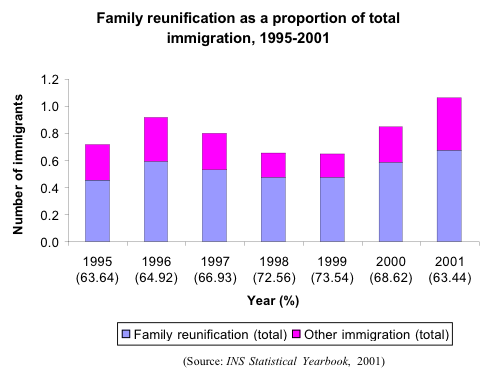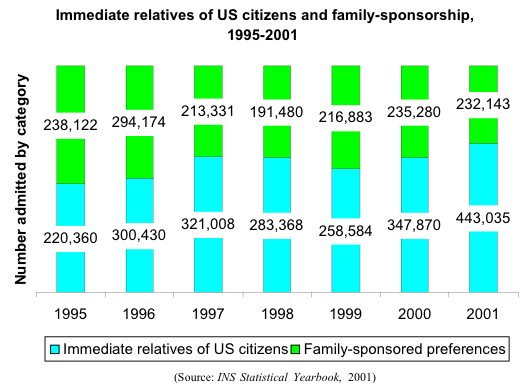Family Reunification
This Spotlight examines the family reunification program, which accounts for approximately two-thirds of permanent immigration to the United States each year.
Click on the bullet points below for more information:
- Family reunification is the largest of four major avenues through which individuals qualify for admission and "lawful permanent residence" in the U.S..
- The majority of new immigrants each year come through family reunification. The program is particularly important for immigrants from specific countries.
- Within family reunification, there are two broad subcategories: (1) immediate relatives of U.S. citizens, and (2) family sponsorship according to preference categories.
- The family reunification program preference categories are subject to annual caps.
- The family reunification program faces an ever-larger number of backlogged applications.
Family reunification is the largest of four major avenues through which individuals qualify for admission and "lawful permanent residence" in the U.S..
Applicants for "lawful permanent residence" in the United States generally enter through one of four channels. Family reunification is the largest of these channels and accounts for approximately two-thirds of total permanent immigration to the U.S. every year. The other channels are employment-based immigration, refugees and asylum seekers, and diversity-based immigration (also known as the lottery). These four categories account for more than 99 percent of immigration into the U.S..

The majority of new immigrants each year come through family reunification. The program is particularly important for immigrants from specific countries.
The table below displays data from 2001 showing the top 10 countries of immigration through family reunification, the total number of immigrants, the number admitted under the family reunification program, and the percentage of total immigration.
|
Top ten countries of immigration through family reunification, 2001
|
||||||||||||||||||||||||||||||||||||||||||||||||||
|
Within family reunification, there are two broad subcategories: (1) immediate relatives of U.S. citizens, and (2) family sponsorship according to preference categories.
There are important differences between the two categories. Immediate relatives of U.S. citizens include the non-native spouses of U.S. citizens, unmarried minor children (aged 21 or under) of U.S. citizens, orphans adopted by U.S. citizens, and the parents of U.S. citizens over the age of 21. This category has no numerical ceiling. The number of immigrants entering through this category affects, to a usually marginal degree, the number of places available to immigrants entering through the second set of classes entry, that of family sponsorship.
The family sponsorship part of the preference entry system includes four numerically limited categories:
1. Unmarried, adult (age 21+) sons and daughters of U.S. citizens.
2. Spouses and unmarried sons and daughters of U.S. permanent resident aliens ("green card holders").
3. Married sons and daughters of U.S. citizens.
4. Brothers and sisters of adult U.S. citizens.
Note that in the numerically limited categories, no single country can account for more than seven percent of total admissions.
Visas in each preference category are allocated as follows:
|
Flexible caps for each preference category, 1990 to the present
|
||||||||||||||
|

The family reunification program preference categories are subject to annual caps.
Theoretically, 480,000 slots are available for family reunification. In reality, the immediate family visa slots are unlimited and at least 226,000 visas are guaranteed to individuals entering through the numerically limited, family-sponsored preference categories. During years in which fewer than 254,000 immediate relatives enter, the remaining spaces "spill over" into the family preference categories. The table below displays family preference slots during the years 1992-2001 under the limits established by the Immigration Act of 1990.
|
Annual entrants through family preference, 1992-2001
|
||||||||||||||||||||||
|
Limits are also imposed by country of origin. Immigration from any single country may not exceed seven percent of the total numerically limited family-based immigration annually. For information on specific countries, see www.travel.state.gov/visa_bulletin.html.
Just as unused visas spill over from immediate relatives to other family-sponsored categories, they also spill over from the first preference category to the second, and so on, until they are filled. Unused visas also move between employment-based immigration categories and family reunification.
The family reunification program faces an ever-larger number of backlogged applications.
By 2001, the former INS faced an application backlog of 3.9 million for all benefits, including naturalization and immigrant and non-immigrant visas, four times the number of backlogged applications in 1994. In 2002 the backlog for adjustment of status applications, one of the primary means by which family members of legal permanent residents and U.S. citizens apply for lawful permanent residency, was 966,341. This backlog represented 57 percent of the total caseload. In addition, by the end of 2002, there were more than one million backlogged applications for numerically limited slots in preference category 2 (spouses and children of legal permanent residents). The backlog results in long waiting periods between the time that a petition is approved and the time that a visa may be issued. For some categories of applicants, that wait may be decades long.
Many analysts believe that alleviating the backlog by processing increased numbers of applicants each year and raising the cap on the first and second preference categories would reduce significantly the number of illegal aliens in the United States.
Sources
Interpreter Releases, Vol. 80, No. 12, March 24 2003. Washington DC.
Kramer, Roger. 2001. "Developments in International Migration to the United States." In The United States Report for the Continuous Reporting System on Migration of the Organization for Economic Cooperation and Development. Washington DC.
Migration News. UC Davis.
U.S. Commission on Immigration Reform. 1997. Becoming an American: Immigration and Immigrant Policy. Washington DC.
U.S. Commission on Immigration Reform. 1997. Appendices. Legal Admissions: Permanent. Washington DC.
U.S. Department of Justice, Immigration and Naturalization Service. 2002. Triennial Comprehensive Report on Immigration. Washington DC.
U.S. General Accounting Office. 2001. Immigration Benefits: Several Factors Impede Timeliness of Application Processing. Washington DC.
U.S. State Department. 2003. Visa Bulletin.


